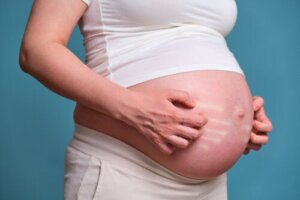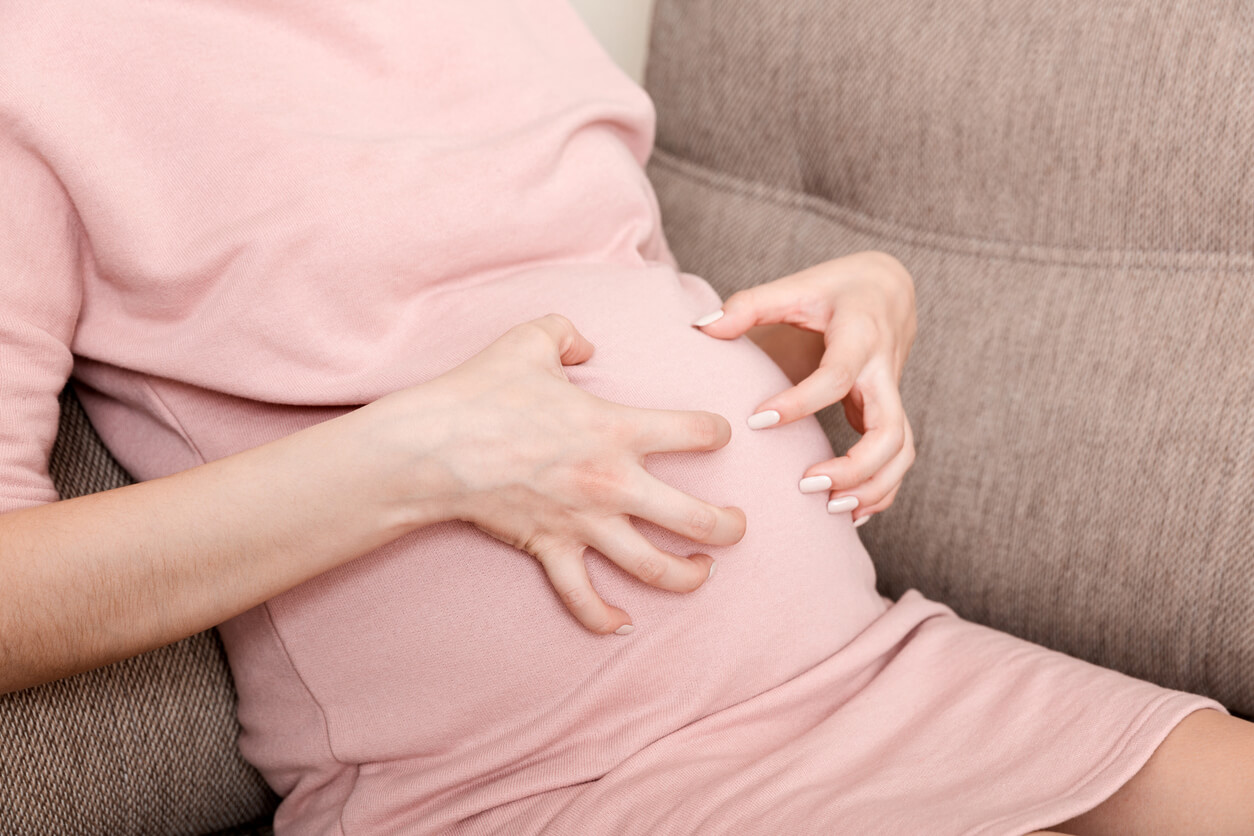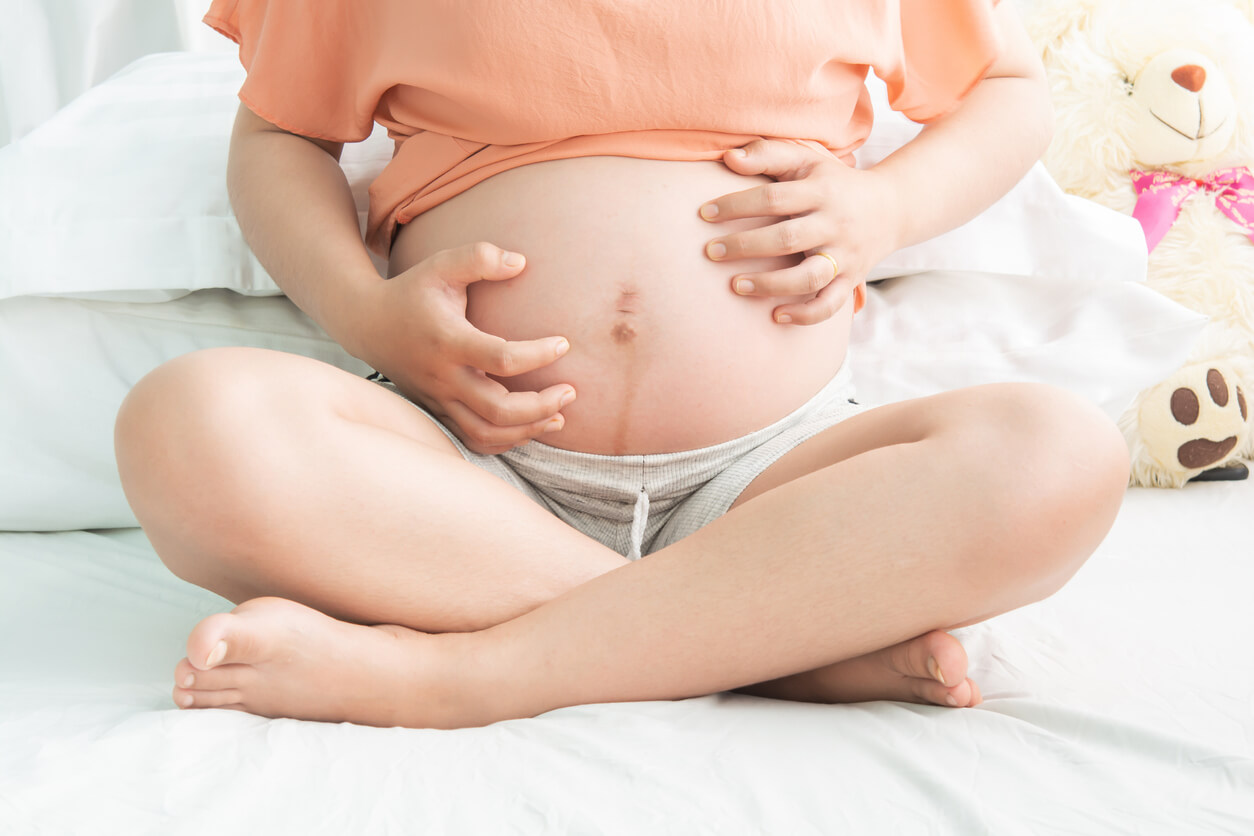Skin Allergies During Pregnancy


Written and verified by the dermatologist Maria del Carmen Hernandez
Skin allergies during pregnancy encompass three general categories of skin conditions. This is due to physiological or hormonal changes, exacerbation of pre-existing skin conditions, or pregnancy-specific manifestations. Whatever their origin, they should never be neglected and symptomatic treatment should be an option.
Skin allergies during pregnancy
Itching and skin changes are common during pregnancy and are usually benign conditions that resolve on their own. In fact, itching is the main clinical manifestation of these conditions. The skin changes vary in location, morphology, and the time of onset, but have many similarities.
Polymorphous eruption of pregnancy
Also known as PUPPP (pruritic urticarial papules and plaques of pregnancy), it’s a benign inflammatory disorder that resolves spontaneously. In most cases, it usually affects first-time mothers during the third trimester of pregnancy or in the early postpartum period.
Clinical manifestations
Symptoms begin in the abdominal region, often where stretch marks appear, along with an intense, pruritic urticarial rash with erythematous and edematous plaques and papules. A distinctive feature is the undamaged preservation of the umbilicus. The pathology even spreads to different parts of the body, such as the back, buttocks, and proximal thighs.
Optional treatment
Treatment is based on mitigating the symptoms. Therefore, topical corticosteroids with or without oral antihistamines are used to control itching and the progression of skin allergies during pregnancy. The reaction is self-limiting and the lesions usually disappear weeks after birth without scarring or pigmentary changes in the injured area.
Read also: 10 Keys to Caring for Sensitive Skin in Pregnant Women During Winter

Intrahepatic cholestasis of pregnancy
Known as pruritus gravidarum, it’s a liver disorder characterized by severe itching and secondary skin lesions in the third trimester of pregnancy. The origin is multifactorial and involves an interaction between genetic predisposition, hormonal changes, and exogenous factors.
Clinical manifestations
This skin allergy in pregnancy is characterized by severe pruritus, without primary skin lesions, with or without jaundice. Consequently, itching starts on the soles and palms of the hand and then becomes generalized. Secondary lesions are usually excoriations or prurigo nodules from scratching.
The treatment of cholestasis
Symptoms tend to resolve on their own within two days of delivery, except on some occasions, it persists for a few weeks.
You may be interested in: 5 Ways to Moisturize Dry Skin During Pregnancy
Atopic eruption of pregnancy
This is a benign and pruritic condition in which papular or eczematous lesions occur in patients with a predisposition or history of atopic dermatitis. Atopic eruption of pregnancy is the most frequent cause of pruritus during this period, with a prevalence of 5 to 20%.
Clinical manifestations
The symptomatology starts early in the first or second trimester and tends to reappear in the following pregnancies due to the atopic base of the person. The main symptoms are pruritic excoriations/lesions, itching, and eczematous skin lesions. In fact, intense scratching causes excoriations that are vulnerable to the development of secondary skin infections.
Therapeutic options
Treatment will depend on the severity of the condition of the pregnant woman. Although the use of topical corticosteroids is usually sufficient, in more severe cases, systemic corticosteroids or antihistamines tend to be used. When scratching causes secondary bacterial infections (with staphylococci or streptococci), antibiotic treatment should be used.

Pemphigoid gestationis
Previously known as herpes gestationis, it’s a rare skin condition during pregnancy that’s characterized by blistering.
Clinical manifestations
It usually manifests in the third trimester of pregnancy with inflammatory skin lesions and intense itching. In addition, it tends to recur in subsequent pregnancies in a more prompt and severe manner. The rash is polymorphic, where pruritus is the main symptom and, in most cases, precedes the cutaneous manifestations.
The treatment of pemphigoid gestationis
Pemphigoid gestationis resolves within two months after delivery. However, therapeutic management depends on the severity of the condition and the stage of the skin lesions. The aim of the measures to be implemented is to relieve itching and prevent the development of new blisters.
Skin allergies and pregnancy
During pregnancy, there are important hormonal, metabolic, immune, and vascular changes that can have an impact on the skin’s surface. Allergies during pregnancy should never be neglected and their cause should always be diagnosed. What’s more, most tend to resolve postpartum and only require symptom management.
Some recommendations for prevention include constant moisturizing, the use of lukewarm water in baths and showers, not wearing tight clothing, and avoiding scratching.
Skin allergies during pregnancy encompass three general categories of skin conditions. This is due to physiological or hormonal changes, exacerbation of pre-existing skin conditions, or pregnancy-specific manifestations. Whatever their origin, they should never be neglected and symptomatic treatment should be an option.
Skin allergies during pregnancy
Itching and skin changes are common during pregnancy and are usually benign conditions that resolve on their own. In fact, itching is the main clinical manifestation of these conditions. The skin changes vary in location, morphology, and the time of onset, but have many similarities.
Polymorphous eruption of pregnancy
Also known as PUPPP (pruritic urticarial papules and plaques of pregnancy), it’s a benign inflammatory disorder that resolves spontaneously. In most cases, it usually affects first-time mothers during the third trimester of pregnancy or in the early postpartum period.
Clinical manifestations
Symptoms begin in the abdominal region, often where stretch marks appear, along with an intense, pruritic urticarial rash with erythematous and edematous plaques and papules. A distinctive feature is the undamaged preservation of the umbilicus. The pathology even spreads to different parts of the body, such as the back, buttocks, and proximal thighs.
Optional treatment
Treatment is based on mitigating the symptoms. Therefore, topical corticosteroids with or without oral antihistamines are used to control itching and the progression of skin allergies during pregnancy. The reaction is self-limiting and the lesions usually disappear weeks after birth without scarring or pigmentary changes in the injured area.
Read also: 10 Keys to Caring for Sensitive Skin in Pregnant Women During Winter

Intrahepatic cholestasis of pregnancy
Known as pruritus gravidarum, it’s a liver disorder characterized by severe itching and secondary skin lesions in the third trimester of pregnancy. The origin is multifactorial and involves an interaction between genetic predisposition, hormonal changes, and exogenous factors.
Clinical manifestations
This skin allergy in pregnancy is characterized by severe pruritus, without primary skin lesions, with or without jaundice. Consequently, itching starts on the soles and palms of the hand and then becomes generalized. Secondary lesions are usually excoriations or prurigo nodules from scratching.
The treatment of cholestasis
Symptoms tend to resolve on their own within two days of delivery, except on some occasions, it persists for a few weeks.
You may be interested in: 5 Ways to Moisturize Dry Skin During Pregnancy
Atopic eruption of pregnancy
This is a benign and pruritic condition in which papular or eczematous lesions occur in patients with a predisposition or history of atopic dermatitis. Atopic eruption of pregnancy is the most frequent cause of pruritus during this period, with a prevalence of 5 to 20%.
Clinical manifestations
The symptomatology starts early in the first or second trimester and tends to reappear in the following pregnancies due to the atopic base of the person. The main symptoms are pruritic excoriations/lesions, itching, and eczematous skin lesions. In fact, intense scratching causes excoriations that are vulnerable to the development of secondary skin infections.
Therapeutic options
Treatment will depend on the severity of the condition of the pregnant woman. Although the use of topical corticosteroids is usually sufficient, in more severe cases, systemic corticosteroids or antihistamines tend to be used. When scratching causes secondary bacterial infections (with staphylococci or streptococci), antibiotic treatment should be used.

Pemphigoid gestationis
Previously known as herpes gestationis, it’s a rare skin condition during pregnancy that’s characterized by blistering.
Clinical manifestations
It usually manifests in the third trimester of pregnancy with inflammatory skin lesions and intense itching. In addition, it tends to recur in subsequent pregnancies in a more prompt and severe manner. The rash is polymorphic, where pruritus is the main symptom and, in most cases, precedes the cutaneous manifestations.
The treatment of pemphigoid gestationis
Pemphigoid gestationis resolves within two months after delivery. However, therapeutic management depends on the severity of the condition and the stage of the skin lesions. The aim of the measures to be implemented is to relieve itching and prevent the development of new blisters.
Skin allergies and pregnancy
During pregnancy, there are important hormonal, metabolic, immune, and vascular changes that can have an impact on the skin’s surface. Allergies during pregnancy should never be neglected and their cause should always be diagnosed. What’s more, most tend to resolve postpartum and only require symptom management.
Some recommendations for prevention include constant moisturizing, the use of lukewarm water in baths and showers, not wearing tight clothing, and avoiding scratching.
All cited sources were thoroughly reviewed by our team to ensure their quality, reliability, currency, and validity. The bibliography of this article was considered reliable and of academic or scientific accuracy.
- Roth MM. Pregnancy dermatoses: diagnosis, management, and controversies. Am J Clin Dermatol. 2011 Feb 1;12(1):25-41. doi: 10.2165/11532010-000000000-00000. PMID: 21110524. https://pubmed.ncbi.nlm.nih.gov/21110524/
- Ambros-Rudolph CM, Müllegger RR, Vaughan-Jones SA, Kerl H, Black MM. The specific dermatoses of pregnancy revisited and reclassified: results of a retrospective two-center study on 505 pregnant patients. J Am Acad Dermatol. 2006 Mar;54(3):395-404. doi: 10.1016/j.jaad.2005.12.012. PMID: 16488288. https://pubmed.ncbi.nlm.nih.gov/16488288/
- Kukkamalla RM, Bayless P. Pemphigoid Gestationis. Clin Pract Cases Emerg Med. 2019 Jan 7;3(1):79-80. doi: 10.5811/cpcem.2018.11.39258. PMID: 30775676; PMCID: PMC6366384. https://pubmed.ncbi.nlm.nih.gov/30775676/
This text is provided for informational purposes only and does not replace consultation with a professional. If in doubt, consult your specialist.








